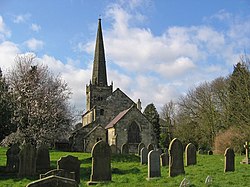Huggate
| Huggate | |
| Yorkshire East Riding | |
|---|---|
 St Mary's Church, Huggate | |
| Location | |
| Grid reference: | SE881551 |
| Location: | 53°59’6"N, 0°39’27"W |
| Data | |
| Population: | 342 (2011) |
| Post town: | York |
| Postcode: | YO42 |
| Dialling code: | 01377 |
| Local Government | |
| Council: | East Riding of Yorkshire |
| Parliamentary constituency: |
East Yorkshire |
Huggate is a village in the East Riding of Yorkshire, nine miles west of Driffield town centre and thirteen miles north-west of Beverley's. The village of North Dalton is four miles to the south-east.
The 2011 census recorded a parish population of 342.
Huggate has one of the deepest wells in Britain. The village contains the Wolds Inn public house on the Driffield Road.
The parish church, St Mary, is a Grade I listed building.[1]
The Yorkshire Wolds Way National Trail, a long distance footpath passes to the north of the village. There are walks through the local area.
History
The name 'Huggate' is derived possibly from the Old Norse haugr and gata,[2] meaing 'Hill street'.
In 1823 Huggate was noted as a parish in the Harthill Wapentake. The parish church was under the patronage of the King; a Methodist chapel also existed. A well 116 yards deep, supplied the village with water. At the end of July each year were held races. The population at the time was 413, with occupations including fourteen farmers, one of whom was also a butcher, a carpenter, two shopkeepers, a tailor, and a shoemaker. The landlord of The Chaise Inn public house was also a blacksmith and gunsmith. The parish rector and curate, and the vicar of the village of Warter resided in Huggate. A carrier operated between the village and Pocklington once a week.[3]
Huggate Wold airstrip
To the north-west of the village, south of the A166 road is Huggate Wold.[4] In the early 1940s, the site was surveyed for a bomber base, and building nearly went ahead, but a better location was found further west, which became RAF Full Sutton.[5][6] However, in October 1943, the Royal Air Force created an airstrip from steel mesh at Huggate Wold to test the airstrip in preparation for the forthcoming invasion of Europe, which would require 'pop-up' airfields. Two RAF squadrons, 168 Sqn and 170 Sqn, both equipped with North American Mustang aircraft under the control of No. 123 Airfield Headquarters, spent a week at the temporary airfield continually landing and taking-off so that the steel mesh airstrip could be assessed. It also gave the pilots and ground crew the experience of using the steel mesh airstrip in a field with no facilities.
Outside links
| ("Wikimedia Commons" has material about Huggate) |
- Huggate in the Domesday Book
- Wold's Villages: Huggate
- National Heritage List 1084147: St Mary's Church
References
- ↑ National Heritage List 1084147: Church of St Mary (Grade I listing)
- ↑ Mills, Anthony David: 'A Dictionary of British Place-Names' (Oxford University Press, 2003) ISBN 978-0-19-852758-9
- ↑ Baines, Edward: 'History, Directory and Gazetteer of the County of York' (1823); page 224
- ↑ "Huggate Wold - Airfields of Britain Conservation Trust UK". https://www.abct.org.uk/airfields/airfield-finder/huggate-wold/.
- ↑ Halpenny, Bruce Barrymore (1982). Action stations.. Cambridge: Stephens. p. 95. ISBN 0-85059-532-0.
- ↑ Otter, Patrick (2003). Yorkshire airfields in the Second World War. Newbury: Countryside Books. p. 129. ISBN 1-85306-542-0.
- Gazetteer — A–Z of Towns Villages and Hamlets. East Riding of Yorkshire Council. 2006. p. 7.
